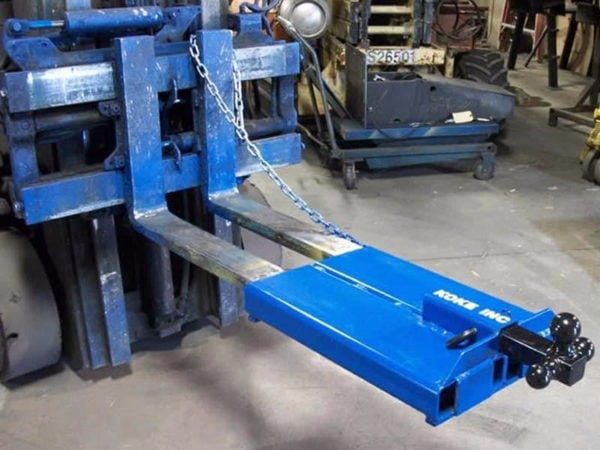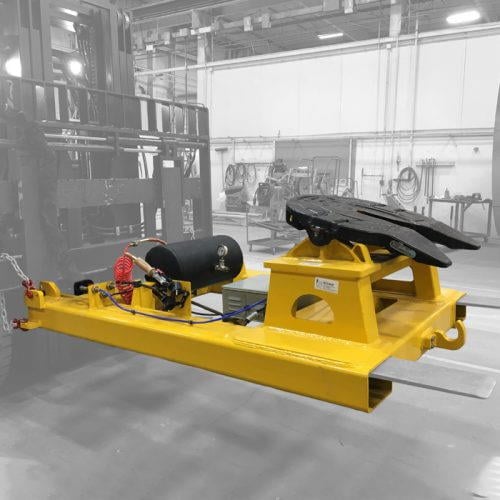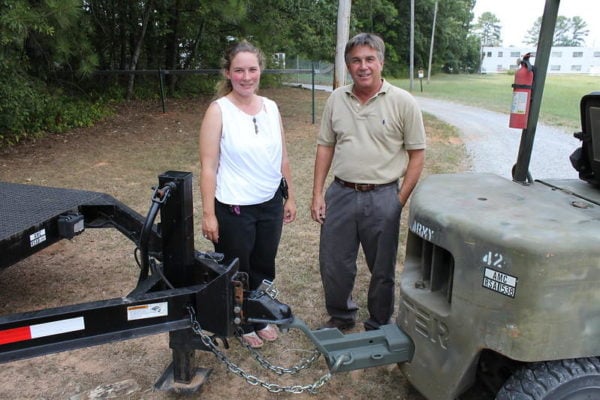Forklifts are not designed for towing, but there are three common scenarios where a forklift might be used to move vehicles using an attachment. Because attachments are custom engineered for specific purposes they can be designed to enable forklifts to safely tow a vehicle in certain circumstances.
Towball, ball hitch or pintle hook attachment
This is almost always an attachment that slides over the forks and consists of a towball which fits to a standard trailer. This is extremely common for moving caravans, small boats and small trailers.

There are systems that fit onto the back of a forklift, but these are much less common because
- the forklift already has all its weight at the back and adding more is not desirable
- an attachment on the forks is much more flexible
- there’s a risk of pulling the counterweight off the back of the forklift if it’s overloaded
In any system, the tow ball itself must be rated to the load being towed so that it doesn’t snap off. The forklift driver must make sure that the attachment is securely attached to the forklift otherwise it could fall off, meaning the towed vehicle could run away.
Fifth wheel attachment
A fifth wheel attachment fits over both forks and connects to a semitrailer kingpin. This enables a forklift to move a semitrailer up to the weight specified on the attachment.

Car mover attachment
A car mover attachment is an uncommon attachment used for towing cars short distances. The attachment lifts the vehicle’s wheels safely using articulating arms in order to allow it to be towed.
Why is towing a trailer with a forklift not advised?
A forklift has a towing attachment at the rear, but this is for towing the forklift itself, for example, to load it onto a trailer if it’s incapacitated. Forklifts rarely tow from the rear with attachments, although, there are devices that can do this.

Because forklifts steer from the rear, the turning momentum is much quicker than when a vehicle is towed from the rear and steered from the front. Care must be taken not to jackknife the forklift and trailer, or for the trailer to push the forklift over (remember that forklifts are inherently unstable when unloaded as the majority of the weight is over the counterbalance).
Trailer brakes may not be able to be activated unless the attachment has a specific system to connect it to trailer brakes. This may not be a problem for small, light trailers such as boat trailers and caravans, but when moving a large semitrailer, there is a risk that the trailer can run away. Plus, the trailer is exerting forces on the forklift to push it. If the area you will be towing is anything other than flat, you may want to think about whether a forklift is the best option for towing.
The forklift’s brakes are designed to brake its own weight when unladen or when carrying a load on the forks, not when being pushed horizontally by another force.
The higher the forks are lifted, the more likely it is that the trailer could tip the forklift; the stability triangle still applies even if it’s a horizontal force rather than a vertical force.
If you do tow a vehicle using a forklift, you must make sure that you do not exceed the maximum load rating as described on the rating plate or data plate.
Can you use a forklift to push or nudge an object?
It’s not advised to use a forklift to push or nudge an object.
- Forks can easily puncture an object
- It’s possible to bend the tips of the forks (they are designed for lifting, not pushing)
- An object could fall over and fall onto someone or something else, damaging it
- Pushing with the counterbalance can damage the counterbalance.

